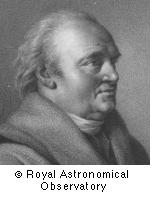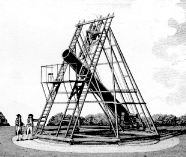Sir William (Frederick) Herschel
Astronomer; b. 15 November 1738 (Hannover, Hanover [Germany]), d. 25 August 1822 (Slough, England).
 Friedrich William Herschel came from a musician's family and as a young man played the oboe in the band of the Hanoverian Guards. He moved to England before turning 20 and eventually became a music teacher and organist in Bath. He also composed own works and gave successful concerts.
Friedrich William Herschel came from a musician's family and as a young man played the oboe in the band of the Hanoverian Guards. He moved to England before turning 20 and eventually became a music teacher and organist in Bath. He also composed own works and gave successful concerts.
In his spare time Herschel developed an interest in astronomy. Dissatisfied with a rented telescope he decided to get a larger one. When the local foundries could not produce the large mirrors he wanted he decided to produce them himself. Assisted by his brother Alexander and his sister Caroline he cast and polished his mirrors in the basement of his house. He also produced his own eyepieces with a magnifying power that reached 6,450.
By 1781 Herschel had made three surveys of the sky, counting the stars with his powerful telescopes, when he discovered the planet Uranus. As a result the Royal Society of London awarded him the Copley Medal and elected him a fellow, and King George III gave him an annual pension of £200 and made him "court astronomer". Herschel left the music business and at the age of 43 became a professional astronomer.
Herschel concentrated his studies on nebulae, which his telescopes were able to resolve into stars. His paper On the Construction of the Heavens, published in 1784, modelled the formation of the Milky Way as a galaxy and marked the beginnings of his life-long interest in the cataloguing of the Universe. In 1789 he built his largest telescope, with a diameter of 122 cm and a focal length of 12 metres, one of the technical wonders of the 18th century.
 Herschel's telescopes were stationary instruments that did not follow the moving sky, and Herschel had to stand on a ladder and call out the objects that passed through the field of view to his sister. From their observations, which eventually covered the entire sky visible in Great Britain, they concluded that some nebulae are galaxies while others are gas clouds. They also discovered binary stars and showed that they revolve around each other.
Herschel's telescopes were stationary instruments that did not follow the moving sky, and Herschel had to stand on a ladder and call out the objects that passed through the field of view to his sister. From their observations, which eventually covered the entire sky visible in Great Britain, they concluded that some nebulae are galaxies while others are gas clouds. They also discovered binary stars and showed that they revolve around each other.
To explain his discoveries Herschel developed a theory of cosmogony based on the principle of evolution. In 1785 he proposed that all stars were originally evenly distributed and gradually pulled into galaxies by gravitational forces. When he discovered a gas nebula in 1790 he suggested that the stars themselves had formed through condensation from the original gas.
In 1800 Herschel observed the Sun with different coloured filters and used a thermometer to measure the heat that passed through them. He noticed an increase in temperature in the infrared and concluded that heat is concentrated in "calorific rays", now called infrared radiation.
Despite his advanced ideas on evolution of the universe Herschel always believed that all stars shine with the same luminosity and that differences in brightness are an indication of their distance. He refused to change his position even as evidence accumulated that proved him wrong on this point.
After Herschel's death his son John took his father's instrument to South Africa to survey the southern skies. In 1864 John Herschel published The General Catalogue of Nebulae of 5097 objects; 4630 of them were discovered by William and John Herschel. The catalogue was revised and enlarged to 7840 nebulae and clusters in 1888 by L. E. Dreyer and re-issued as the New General Catalogue. Most non-stellar objects are still known by their new General Catalogue (NGC) numbers today.
References
European Space Agency (2004), Revealing the invisible: Caroline and William Herschel.
http://www.esa.int/export/esaSC/SEM8600P4HD_people_0.html (accessed 24 September 2004).
Sir William (Frederick) Herschel. Encyclopaedia Britannica 15th ed. (1995).
Taylor, P. and S. Saey (2004), Friedrich Wilhelm Herschel.
http://www.astroleague.org/al/obsclubs/herschel/fwhershs.html (accessed 24 September 2004).
home
 Friedrich William Herschel came from a musician's family and as a young man played the oboe in the band of the Hanoverian Guards. He moved to England before turning 20 and eventually became a music teacher and organist in Bath. He also composed own works and gave successful concerts.
Friedrich William Herschel came from a musician's family and as a young man played the oboe in the band of the Hanoverian Guards. He moved to England before turning 20 and eventually became a music teacher and organist in Bath. He also composed own works and gave successful concerts. Herschel's telescopes were stationary instruments that did not follow the moving sky, and Herschel had to stand on a ladder and call out the objects that passed through the field of view to his sister. From their observations, which eventually covered the entire sky visible in Great Britain, they concluded that some nebulae are galaxies while others are gas clouds. They also discovered binary stars and showed that they revolve around each other.
Herschel's telescopes were stationary instruments that did not follow the moving sky, and Herschel had to stand on a ladder and call out the objects that passed through the field of view to his sister. From their observations, which eventually covered the entire sky visible in Great Britain, they concluded that some nebulae are galaxies while others are gas clouds. They also discovered binary stars and showed that they revolve around each other.